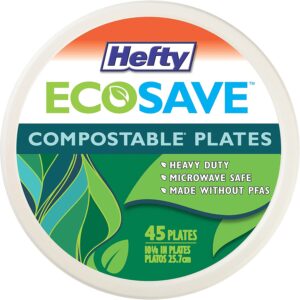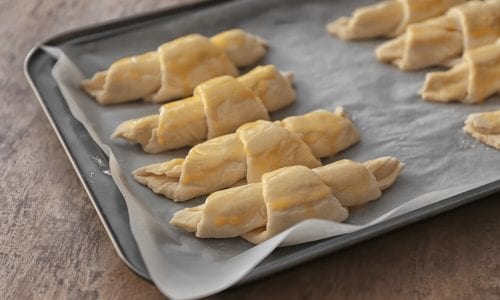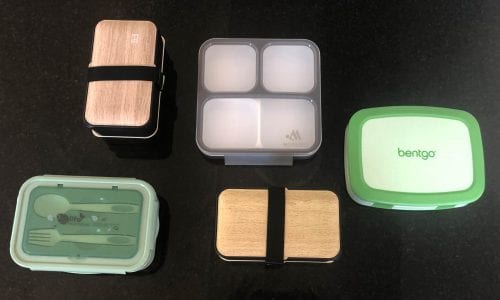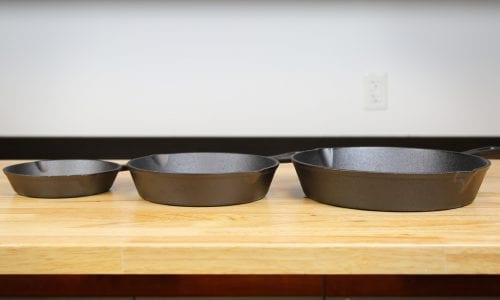The Best Compostable Paper Plates

Our Review Process
Don't Waste Your Money is focused on helping you make the best purchasing decision. Our team of experts spends hundreds of hours analyzing, testing, and researching products so you don't have to. Learn more.
Our Picks For The Top Compostable Paper Plates
- 1. Earth’s Natural Alternative Compostable Paper Plates, 50-Count
- 2. Stack Man Sugarcane Fiber Compostable Paper Plates, 125-Count
- 3. Comfy Package Cut-Resistant Compostable Paper Plates, 250-Count
- 4. CantaGreen Oil-Resistant Compostable Paper Plates, 100-Count
- 5. BIOZOYG Biodegradable Palm Leaf Square Appetizer Plates, 25 Count
- 6. Gezond Assorted Cutlery & Compostable Paper Plates, 250-Count
- 7. Hefty ECOSAVE Plant-Based Compostable Paper Plates, 45-Count
- 8. Vplus Leak-Resistant Compostable Paper Plates, 150-Count
- 9. BIRCHIO Plastic-Free Compostable Paper Plates, 150-Count
- 10. Dixie Recycled Fiber Compostable Paper Plates, 50-Count
- 11. I00000 Microwave Safe Compostable Paper Plates, 100-Count
These strong compostable paper plates are thick and cut resistant. They can fully compost in one to six months in an industrial facility. The plates are made from a quick-growing and renewable plant fiber.
Strong and DurableThese compostable paper plates are thick and cut resistant.
These versatile compostable paper plates work for hot or cold food, and can be microwaved or frozen. The plates are 100 percent compostable in a commercial facility. They are made from renewable and biodegradable sugar cane fiber.
Versatile ChoiceThese compostable paper plates work well for hot or cold food.
These strong compostable paper plates are leak resistant and cut resistant, and won't crack under pressure. They have an authentic brown color for a natural aesthetic. The plates are made from 100 percent sugar cane fiber.
Superior StrengthThese compostable paper plates are leak resistant.
These easy-to-use compostable paper plates can be disposed of in your backyard. They are sturdy and durable, and can be microwaved. The plates work well for both hot and cold food.
Easy to DisposeThese compostable paper plates can be disposed of in your backyard.
Buying Guide
Paper plates come in handy for so many reasons. Whether you’re having a lot of people over and you don’t have enough plates or you just don’t want to do any dishes after a long day, you can simply use paper plates and throw them out when you’re done eating. However, if you’re concerned about the environment, it’s important to look into eco-friendly alternatives. Compostable paper plates are a good idea for those who want a disposable option that is sustainable and good for the environment.
What are compostable paper plates made out of? There are a couple of different materials that are commonly used. Bagasse, which is derived from sugar cane, is often used to make compostable paper plates. It doesn’t require a lot of processing to turn it from wet pulp to paper plates. However, it isn’t always water repellent, so some plates can be flimsy. Some manufacturers who use bagasse add a water and oil repellent which increases the durability of the plates.
Another common material used to make compostable paper plates is bamboo, which is a strong and durable material that grows and replenishes quickly. One of the key benefits of bamboo paper plates is that they don’t require any chemicals in the processing, making them more environmentally friendly. Some compostable paper plates are made from palm tree leaves, which are collected once they fall naturally to the ground. This process doesn’t contribute to deforestation, an added benefit. The plates made from palm tree leaves are 100 percent compostable as no binders or chemical agents are required during the manufacturing process.
Another option for compostable paper plates are vegetable starches, such as those from potatoes and corn. Compostable bioplastics are nontoxic and can be decomposed fully in an industrial facility. These plates have similar characteristics to plastic plates. However, they do require a lot of energy to process and manufacture and may also emit greenhouse gas emissions.
What to Look For
- When searching for compostable paper plates, it’s likely you’ll come across a lot of “green” terminology used in the marketing and packaging of the paper plates. However, it’s important to know that not all green terms are interchangeable. So what do they all mean? Some paper plates may say they are biodegradable. This means that when disposed, the plate can break down naturally into microorganisms over a certain period of time. It’s likely that these plates are made from plant or animal products. Compostable means that when disposed, the plates will break down into water, carbon dioxide, or a reusable biomass without releasing any harmful toxins into the environment.
- If you see paper plate packaging that says they are degradable, this means that they contain oil-based products. They cannot break down naturally. If plates say they are recyclable, it means that they can be reused to make a new product after they have been discarded. Any paper plate packaging that says they renewable means that the materials used to make them can regenerate themselves, such as trees or plants.
- How many compostable paper plates will you need? You can find them packaged in a range of quantities, from around 50 plates to over 200 plates. In some cases, purchasing plates in large quantities may result in a per plate cost savings, so it may be beneficial to go for the bigger package, regardless of how many plates you need to use at one time.
More to Explore
Did you know there is a correct way to dispose of compostable paper plates? It actually depends on the materials the plates are made out of. If you have compostable paper plates made from vegetable starches, they need to be sent to a composting facility because they require high temperatures in order to fully compost. However, if you have compostable paper plates made from bagasse, bamboo and palm leaves, then you can actually compost them in your garden or compost pile. Just cut the plates up into small pieces and ensure there is enough other green material in the compost pile to add the necessary moisture.





















